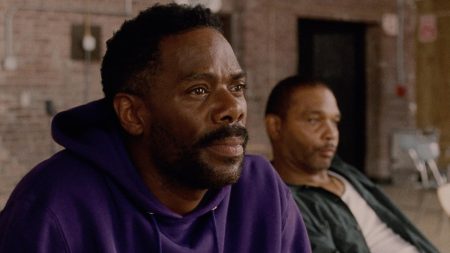The Evolution of TV Procedurals: A New Era of Innovation and Reinvention
In an ever-changing television landscape, the traditional procedural drama is undergoing a creative rebirth.Craig Sweeny, a seasoned producer and screenwriter, found inspiration for his latest project while driving. He envisioned a show that would blend the quintessential hospital procedural with the iconic lore of Sherlock Holmes. This idea led to the creation of Watson, a CBS series featuring Morris Chestnut as the titular Dr. John Watson, who leads a team of medical detectives in a modern-day Pittsburgh populated with characters from the Arthur Conan Doyle universe. Sweeny, who previously worked on Elementary, a contemporary take on the Sherlock Holmes stories, saw an opportunity to merge two compelling genres, creating a unique viewing experience. Instead of forcing the two concepts together, he found that the connection between Holmes’ trusted sidekick and the medical procedural was organic and seamless.
The Rise of Reinvented Procedurals
Procedural dramas, long considered the bedrock of television, are being reimagined with fresh twists and creative mashups. While shows like NCIS, FBI, and Chicago Med continue to dominate prime-time slots with their tried-and-true formulas, networks are now experimenting to stand out. ABC’s Doctor Odyssey takes the medical procedural to new heights—literally—by setting it on a luxury cruise ship, while NBC’s The Hunting Party blends the suspense of The Blacklist with the psychological depth of Criminal Minds. Meanwhile, Matlock, another CBS series, features Kathy Bates as an underestimated retirement-age lawyer with a secret mission for vengeance. These shows demonstrate how the procedural format, while familiar, offers endless opportunities for innovation.
Jonathan Tolins, a playwright, TV writer, and showrunner, highlights the enduring appeal of procedurals. “There’s something really pleasurable about the self-contained, 43-minute procedural,” he explains. “It gives you a beginning, middle, and end, a little bit of a mystery, and the fun of watching something get figured out.” Tolins’ own contribution to the genre is Elsbeth, a CBS show that spins off the quirky character Elsbeth Tascioni from The Good Wife and places her in a Columbo-style police procedural. Elsbeth, played by Carrie Preston, is a blunt, unpredictable sleuth who stands out as much for her bright colors and bucket hat as her sharp mind. Tolins emphasizes that the key to Elsbeth’s success lies in making her feel like a disruptor rather than a traditional lead, often positioning her on the periphery of scenes to create a sense of dynamic tension.
The Influence of Streaming on Network TV
The rise of streaming platforms has undeniably reshaped the television landscape. Services like Netflix, Hulu, and Peacock are producing short-run, high-concept series with big-name talent and polished production values. These shows often push boundaries, catering to niche audiences with unconventional storytelling. As a result, network TV is feeling the pressure to innovate. “I think that, inevitably, the innovations that streaming is doing bleed into what happens in network TV and challenge what we’re doing to compete for eyeballs in a healthy way,” notes Craig Sweeny.
One example of streaming’s influence is Poker Face, a Peacock series that nods to the classic Columbo format, and Max’s The Pitt, which reimagines the medical drama by breaking down a single hospital shift into multiple episodes, à la 24. These experiments are forcing network TV to think outside the box. At the same time, streaming platforms are beginning to envy the broad reach and consistency of network audiences. The gap between the two mediums is narrowing, with networks offering writers more creative freedom and streaming services aspiring to replicate the mass appeal of traditional television.
The Art of Mixing Genres and Elevating Procedurals
While the procedural format remains a staple, its longevity depends on its ability to evolve. Showrunners like Todd Harthan, behind ABC’s High Potential, are proving that even familiar concepts can be elevated with unique characters. High Potential centers on a police genius who also happens to be a single mother of three, played by Kaitlin Olson. Harthan describes her character as “a bit of a unicorn”—a brilliant but unconventional thinker who challenges her colleagues to think differently. “You throw a unicorn into the bullpen with a bunch of detectives, and they go, ‘What are we supposed to do with this colorful creature with the horn coming out of her head?’” he says.
The success of these elevated procedurals lies in their ability to balance innovation with familiarity. Showrunners caution that mixing elements can’t be arbitrary; the new twists must feel organic to the story. For example, Sweeny notes that Dr. Watson’s background as a medical professional in the Sherlock Holmes universe made him the perfect candidate to lead a modern-day medical team. “It is an exotic combo, but it’s also very organic,” he explains. “Mechanically, you don’t have to force anything into place. Everything’s already there.” Similarly, in Elsbeth, the character’s quirks and strengths were already established in The Good Wife, making her transition to a police procedural feel natural.
The Future of Television: A Hybrid of Network and Streaming
As television continues to evolve, the lines between network and streaming content are becoming increasingly blurred. Robert and Michelle King, the creators of hits like The Good Wife and Evil, emphasize that their approach to storytelling is medium-agnostic. “We don’t start with, ‘Oh, we must do a network show,’ or, ‘We must do a streaming show,’” says Michelle King. “It’s very much, ‘This idea we have fits more comfortably either in network or in streaming.’” The Kings point to The Sopranos as one of the earliest examples of this hybrid approach, blending serialized storytelling with a mix of humor and drama.
The convergence of network and streaming is creating a new era of television that feels both familiar and fresh. Tolins recalls a particularly satisfying moment during a focus group for Elsbeth, where a viewer remarked, “This is network? I’m going to have to watch more network television.” Such feedback underscores the growing appreciation for elevated procedurals that defy expectations while staying true to the genre’s roots. As streaming and network TVcontinue to borrow from and inspire each other, audiences can look forward to a future filled with bold, innovative storytelling that challenges the status quo.
In this new era of television, the procedural drama is far from stale. Instead, it’s becoming a canvas for creativity, inviting writers and showrunners to experiment with new characters, settings, and genre mashups. Whether it’s a medical detective solving crimes in Pittsburgh or a colorful sleuth disrupting traditional police procedurals, these shows are proving that even the most familiar formats can feel brand new.















